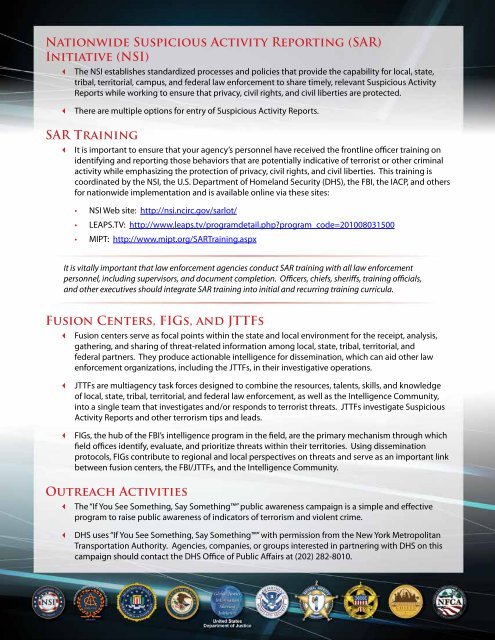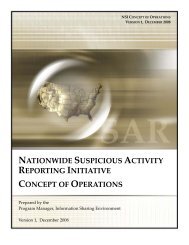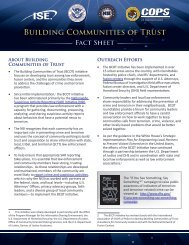Nationwide SAR Initiative Annual Report 2011 - The Nationwide ...
Nationwide SAR Initiative Annual Report 2011 - The Nationwide ...
Nationwide SAR Initiative Annual Report 2011 - The Nationwide ...
Create successful ePaper yourself
Turn your PDF publications into a flip-book with our unique Google optimized e-Paper software.
<strong>Nationwide</strong> Suspicious Activity <strong>Report</strong>ing (<strong>SAR</strong>)<strong>Initiative</strong> (NSI)<strong>The</strong> NSI establishes standardized processes and policies that provide the capability for local, state,tribal, territorial, campus, and federal law enforcement to share timely, relevant Suspicious Activity<strong>Report</strong>s while working to ensure that privacy, civil rights, and civil liberties are protected.<strong>The</strong>re are multiple options for entry of Suspicious Activity <strong>Report</strong>s.<strong>SAR</strong> TrainingIt is important to ensure that your agency’s personnel have received the frontline officer training onidentifying and reporting those behaviors that are potentially indicative of terrorist or other criminalactivity while emphasizing the protection of privacy, civil rights, and civil liberties. This training iscoordinated by the NSI, the U.S. Department of Homeland Security (DHS), the FBI, the IACP, and othersfor nationwide implementation and is available online via these sites:• NSI Web site: http://nsi.ncirc.gov/sarlot/• LEAPS.TV: http://www.leaps.tv/programdetail.php?program_code=201008031500• MIPT: http://www.mipt.org/<strong>SAR</strong>Training.aspxIt is vitally important that law enforcement agencies conduct <strong>SAR</strong> training with all law enforcementpersonnel, including supervisors, and document completion. Officers, chiefs, sheriffs, training officials,and other executives should integrate <strong>SAR</strong> training into initial and recurring training curricula.Fusion Centers, FIGs, and JTTFsFusion centers serve as focal points within the state and local environment for the receipt, analysis,gathering, and sharing of threat‐related information among local, state, tribal, territorial, andfederal partners. <strong>The</strong>y produce actionable intelligence for dissemination, which can aid other lawenforcement organizations, including the JTTFs, in their investigative operations.JTTFs are multiagency task forces designed to combine the resources, talents, skills, and knowledgeof local, state, tribal, territorial, and federal law enforcement, as well as the Intelligence Community,into a single team that investigates and/or responds to terrorist threats. JTTFs investigate SuspiciousActivity <strong>Report</strong>s and other terrorism tips and leads.FIGs, the hub of the FBI’s intelligence program in the field, are the primary mechanism through whichfield offices identify, evaluate, and prioritize threats within their territories. Using disseminationprotocols, FIGs contribute to regional and local perspectives on threats and serve as an important linkbetween fusion centers, the FBI/JTTFs, and the Intelligence Community.Outreach Activities<strong>The</strong> “If You See Something, Say Something” public awareness campaign is a simple and effectiveprogram to raise public awareness of indicators of terrorism and violent crime. DHS uses “If You See Something, Say Something” with permission from the New York MetropolitanTransportation Authority. Agencies, companies, or groups interested in partnering with DHS on thiscampaign should contact the DHS Office of Public Affairs at (202) 282‐8010.






